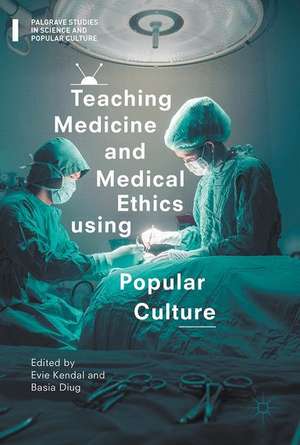Teaching Medicine and Medical Ethics Using Popular Culture: Palgrave Studies in Science and Popular Culture
Editat de Evie Kendal, Basia Diugen Limba Engleză Paperback – 2 noi 2017
This book demonstrates how popular culture can be successfully incorporated into medical and health science curriculums, capitalising on the opportunity fictional media presents to humanise case studies. Studies show that the vast majority of medical and nursing students watch popular medical television dramas and comedies such as Grey’s Anatomy, ER, House M.D. and Scrubs. This affords us with a unique opportunity to engage and inform not only students but the general public and patients further downstream. This volume analyses examples of medical-themed popular culture and offers various strategies and methods for educators in this field to integrate this material into their teaching. The result is a fascinating read and original resource for medical professionals and teachers alike.
Preț: 242.17 lei
Nou
Puncte Express: 363
Preț estimativ în valută:
46.34€ • 47.88$ • 38.55£
46.34€ • 47.88$ • 38.55£
Carte tipărită la comandă
Livrare economică 19 martie-02 aprilie
Preluare comenzi: 021 569.72.76
Specificații
ISBN-13: 9783319654508
ISBN-10: 3319654500
Pagini: 171
Ilustrații: XV, 171 p. 13 illus.
Dimensiuni: 148 x 210 mm
Greutate: 0.23 kg
Ediția:1st ed. 2017
Editura: Springer International Publishing
Colecția Palgrave Macmillan
Seria Palgrave Studies in Science and Popular Culture
Locul publicării:Cham, Switzerland
ISBN-10: 3319654500
Pagini: 171
Ilustrații: XV, 171 p. 13 illus.
Dimensiuni: 148 x 210 mm
Greutate: 0.23 kg
Ediția:1st ed. 2017
Editura: Springer International Publishing
Colecția Palgrave Macmillan
Seria Palgrave Studies in Science and Popular Culture
Locul publicării:Cham, Switzerland
Cuprins
Chapter 1. Introduction: The Use of Popular Culture in Medical and Health Education; Evie Kendal and Basia Diug.- Chapter 2. Hidden in Plain Sight: Family Presence During Resuscitation on Prime-Time Media; Zohar Lederman.- Chapter 3. The ER Effect: How Medical Television Creates Knowledge for American Audiences; Jessica Bodoh.- Chapter 4. whyZombie? Zombie Pop-Culture to Improve Infection Prevention and Control Practices; Peta-Anne Zimmerman and Matt Mason.- Chapter 5. An Empirical Study of How Medical, Biomedical and Health Science Students Engage with Professional and Ethical Issues in Medical Television Dramas; Evie Kendal and Basia Diug.- Chapter 6. Teaching Millennials: Twitter, Celebrity Media and Beyond; Basia Diug and Evie Kendal.- Chapter 7. The Needs of the Many Outweigh the Needs of the Few: Teaching Medical Ethics Using Star Trek; Allie Ford and Lynette Pretorius.- Chapter 8. Mind-Melds and Other Tricky Business: Teaching Threshold Concepts in Mental Health Preservice Training; Lynette Pretorius and Allie Ford.
Notă biografică
Evie Kendal is Lecturer for the School of Public Health and Preventive Medicine at the Alfred Hospital Centre at Monash University, Australia, teaching into the Bachelor of Health Science and Bachelor of Biomedical Science degree programs.
Dr Basia Diug is Senior Lecturer and Deputy-Head of the Medical Education Research and Quality unit (MERQ), at Monash University, Australia.
Textul de pe ultima copertă
This book demonstrates how popular culture can be successfully incorporated into medical and health science curriculums, capitalising on the opportunity fictional media presents to humanise case studies. Studies show that the vast majority of medical and nursing students watch popular medical television dramas and comedies such as Grey’s Anatomy, ER, House M.D. and Scrubs. This affords us with a unique opportunity to engage and inform not only students but the general public and patients further downstream. This volume analyses examples of medical-themed popular culture and offers various strategies and methods for educators in this field to integrate this material into their teaching. The result is a fascinating read and original resource for medical professionals and teachers alike.
Caracteristici
Contains a mix of empirical research studies in education, film and literary textual analyses, literature reviews and practical classroom activities Will be of interest to educators in medicine and literature, film and media studies, but also the general public and students. It is written at an accessible level for all of these audiences Covers popular media in various forms, including film, social media, and advertising. It contains data that can be used to demonstrate the effectiveness of all of these forms on education











